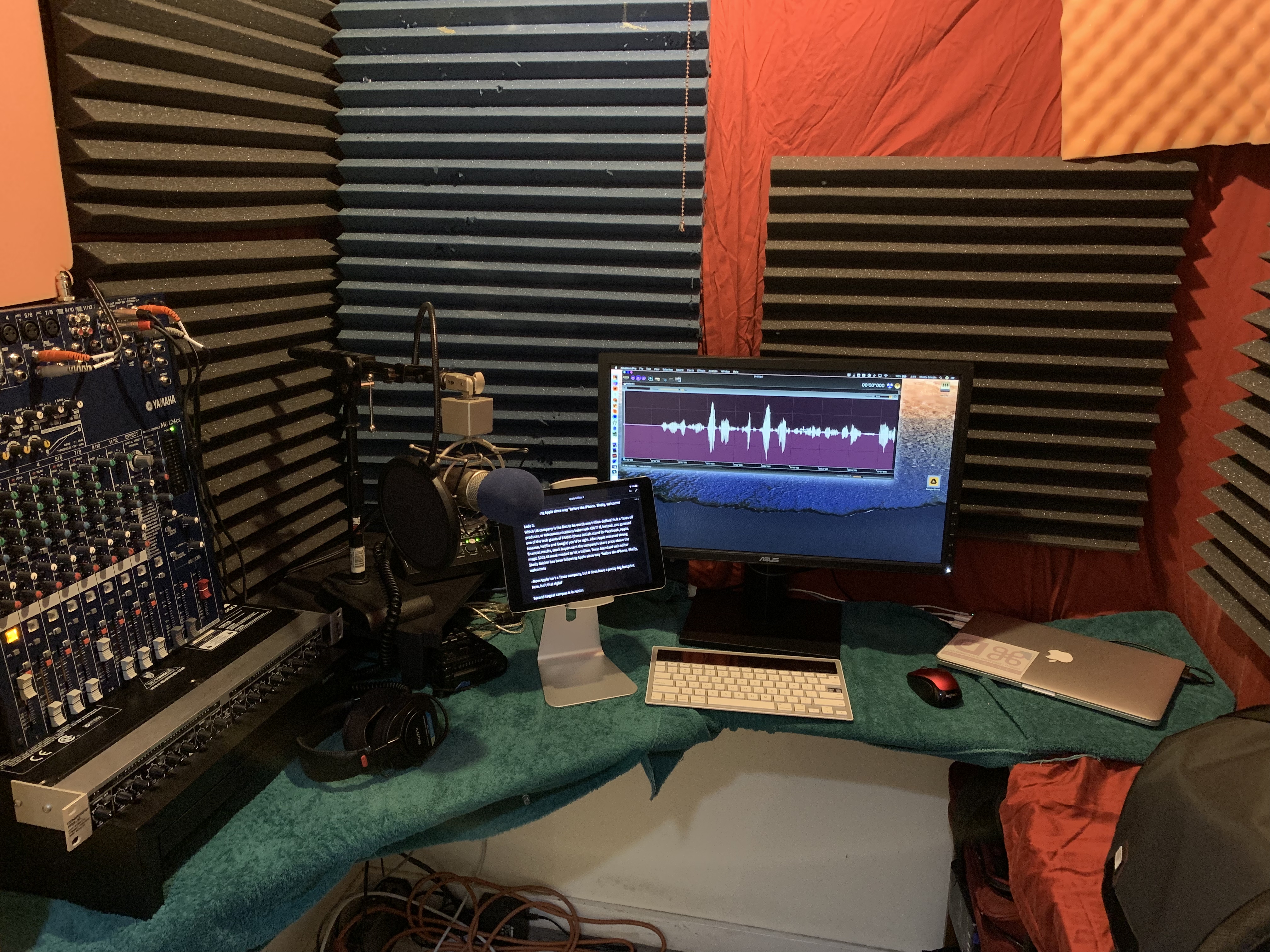I don’t podcast from my office. I made myself a special space for recording.
It’s a former air conditioning closet, and It’s inside our long, skinny utility room, all the way in the back. My husband put up sheetrock and some folding doors and bolted in a piece of plywood to make a desk. I hung old sheets on the walls, and covered them with sound-deadening foam. I covered the desk with old towels and tacked them down, to further deaden the space acoustically. Then I cut a piece of sheetrock to cover the flagstone floor. Finally, I added a rod above the doors and hung sheets from it, to make a curtain, inside the doors. There’s a tiny bookcase under the desk for storage. The space is big enough for one podcaster to sit, and to turn around – but not too quickly.
Back when Macs had line-in jacks, I bought an analog mixer to use in making podcasts, The Yamaha MG24cx (no longer made, but similar to this has six mic inputs, and six other inputs. Even when I chose it, USB and Firewire mixers were popular podcasting gear, but I liked everything about the Yamaha, including the extra I/O busses and plentiful outputs. I could create a mix-minus arrangement, whereby I routed my own audio and that of others for recording and reserve the Mac for running Skype and sending output from guests back to the mixer. All that got complicated when line-in disappeared from Apple machines, and I was finally forced to buy a USB interface. But the Yamaha still works for a living. It’s connected to my Heil PR-40 mic. The mixer’s main output – my mic plus whatever mixer inputs I’m using – to a Mackie Onyx Blackjack USB interface. The Blackjack, in turn, feeds a 2013 MacBook Pro. I’m frankly surprised at how well the old laptop still works as a podcast machine. It’s just a great computer. I could connect the Heil directly to the two-input Blackjack, but the Yamaha’s preamps are better able to drive the Heil, which needs a lot of gain.
Using the mixer allows me to add other inputs, too, like music, an iPad running speech, or a second, third or fourth mic. Of course, the user of that mic would have to be outside the studio. This is not theoretical. My husband has recorded with me from out by the bread machine and the spare tiki mugs, standing in front of a mic whose cable snakes under the door, and into the Yamaha.
I need audio gear to be where I can see it. First, I stood the Yamaha, which is quite large, on its edge. It takes up less space that way, too. I raised it, and the microphone, with some plastic stands I bought. The mic is in a Heil shockmount and a boom stand. I recently acquired a pop filter, after resisting them for years. To me, it feels odd to talk into a big, black loop. But I’ve banished plosives, so it’s worth it.
I bought a 24-inch, nothing special, Asus monitor for the studio. It’s far easier to see than the MacBook screen would be, though I have experimented with stands that raise the computer to 30-45 degrees, for a better view. It’s just easier to clamshell the laptop. I added a Logitech K760 solar Bluetooth keyboard. It can be paired with up to three devices, and in addition to studio duty, it’s my primary iPad travel keyboard.
Speaking of iPads, I sometimes use the 9.7-inch iPad Pro pictured here, for reading scripts on-mic. Mounted in a Viozon stand, the iPad is raised just below the level of the mic, and I can tilt it up to get an even better view. Editorial is a good app for full-screen reading, with font sizes I can control.
Next to the iPad, there’s an old Marantz PMD-660 digital recorder I use to make backup recordings of my tracks. It records mixer output, so just my voice, not my guests. I knew the Sony MDR7506 headphones were a pro podcaster standard, but they’re also de rigueur in the “real” media world – I was issued a pair on my first day as a producer for a radio news show. Now I have two pair. The Behringer compressor that’s underneath the mixer doesn’t actually get much use. I prefer to add compression in software.
Speaking of software, and things not pictured, here are some other tools I use, including gear I carry when I produce for radio, or go to a tech conference to make podcasts.
Software
I use just about all of this stuff, regardless of how I make the podcast. I work exclusively on Macs.
- Adobe Audition
- Amadeus Pro
- Audio Hijack
- Call Recorder
- Skype
- GarageBand
- The Levelator (living on borrowed time)
- Feeder
- MarsEdit
Field Recording
I cover trade shows and conferences, and sometimes record interviews with people I meet. I’ve recently gotten my field recording rig just about where I want it.
- Rode NTG-2 shotgun mic
- Pyl and Shure dynamic mics (the Shure is an SM-58, and the Pyl’s are knockoffs of same)
- Audio-Technica ATR-2100
- Audio-Technica AT804 omnidirectional dynamic mic
- Zoom H6 recorder
- Tascam DR-100mkII recorder
Neither Studio, nor Field
Sometimes, I meet up with podcast pals to record remotely. I believe it is rude to arrive at a party empty-handed, so I carry mixer and mics.
- Mackie 402-VLZ3 mixer
Emeritus Gear
The passage of time, and lust for new stuff means that I retain custody of a few things I no longer use. I’ve sold, given away, or worn out a number of things that don’t appear on this list.
- MXL 990 mic
- M-Audio mics
- M-Audio MobilePre audio interface
- Griffin iMic
- iRiver
- tk clip-on mics
- Really old iPod mics
